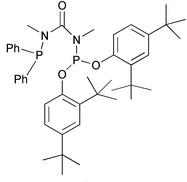P(OC6H3But2-2,4)2N(Me)CON(Me)PPh2: the facile route to an unsymmetrically substituted bisphosphinourea
Abstract
The phosphinourea derivative PPh2N(Me)CON(Me)H 1a and the

* Corresponding authors
a
Institut für Chemie und Biochemie, Ernst-Moritz-Arndt-Universität Greifswald, Soldmannstr. 16, D-17487 Greifswald, Germany
E-mail:
kuhl@uni-greifswald.de
The phosphinourea derivative PPh2N(Me)CON(Me)H 1a and the

 Please wait while we load your content...
Something went wrong. Try again?
Please wait while we load your content...
Something went wrong. Try again?
O. Kühl, Dalton Trans., 2003, 949 DOI: 10.1039/B208244F
To request permission to reproduce material from this article, please go to the Copyright Clearance Center request page.
If you are an author contributing to an RSC publication, you do not need to request permission provided correct acknowledgement is given.
If you are the author of this article, you do not need to request permission to reproduce figures and diagrams provided correct acknowledgement is given. If you want to reproduce the whole article in a third-party publication (excluding your thesis/dissertation for which permission is not required) please go to the Copyright Clearance Center request page.
Read more about how to correctly acknowledge RSC content.
 Fetching data from CrossRef.
Fetching data from CrossRef.
This may take some time to load.
Loading related content
